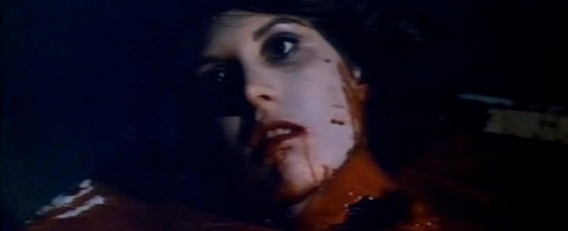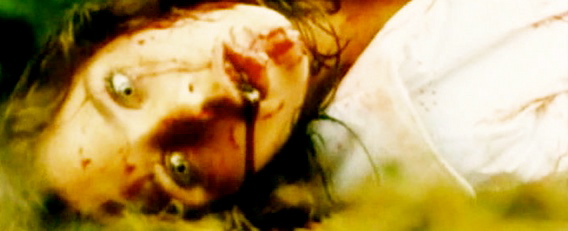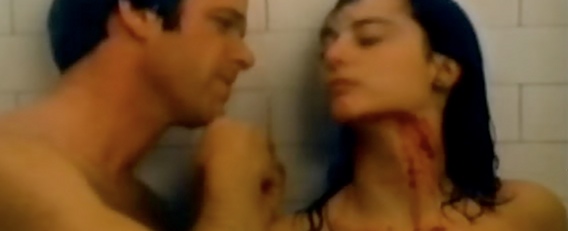
‘Should we then ban the News at Ten?’ asked an article in The Times as the furore surrounding the video nasties increased to ridiculous proportions. It was an interesting point; if the parliament and tabloids were so concerned about upsetting or corrupting the public with scenes of sex or violence, there was nothing as shocking as the stories reported by the news on a day-to-day basis. On June 30th 1983, a list of fifty-two titles were published that the Director of Public Prosecutions (DPP) had considered ‘nasty.’ Amongst these were several slasher films; Anthropophagous: The Beast, Absurd, Bloody Moon, The Boogeyman, The Burning, Don’t Go in the Woods, The Dorm That Dripped Blood, Nightmares in a Damaged Brain, Night School, The Toolbox Murders and Unhinged. Over the next two years, there would be several films that would either be added or removed from the list, with Boogeyman II, The Funhouse and Visiting Hours also finding their way onto later drafts.
The following is a breakdown of the remaining slashers to be featured at one time or another on the DPP’s list of ‘video nasties’…
THE DORM THAT DRIPPED BLOOD
Jeffrey Obrow and Stephen Carpenter were both film students at the University of California in 1980 when they first decided to pull their resources and shoot a low budget horror movie. Facing graduation and the prospect of struggling in the movie industry, they joined forces with classmate Stacey Giachino to develop a concept that could be shot with a miniscule budget and an inexperienced cast and crew. Over the next three months, Obrow and Giachino worked on adapting their ideas into a screenplay, which would eventually take the form of Death Dorm. Using an isolated location – a dormitory that is scheduled for demolition – this allowed for the filmmakers to avoid the usual pitfalls of producing a movie; exterior shooting, a large cast and elaborate set pieces. Having gathered a budget of approximately $90,000, the trio began to assemble a team of collaborators to help bring their concept to the screen.
To create the graphic special effects which they felt would be imperative to the movie’s success, Obrow sought advice from the Joe Blasco Make-up Center in Hollywood and was introduced to Matthew W. Mungle, who would work with the directors again a few years later on The Power and The Kindred. Amongst the cast were two young hopefuls who would go on to enjoy successful careers; Stephen Sachs (who was also credited as stunt coordinator) would become an acclaimed stage director through his work with The Foundation Theatre, whilst Daphne Zuniga would appear in the hit comedy Spaceballs and the popular daytime soap Melrose Place. The score, meanwhile, would be composed by Christopher Young, whose subsequent credits would include Hellraiser. Distributed as The Dorm That Dripped Blood, it would be under the name Pranks that the movie would be included on the DPP’s list of nasties; later released with BBFC cuts in 1992.
THE FUNHOUSE
Following his sudden success with 1974’s independent hit The Texas Chain Saw Massacre, director Tobe Hooper had struggled to keep his career afloat. Eaten Alive (aka Death Trap), released three years later, had failed to prove to be the worthy follow-up fans had hoped, whilst he was later replaced by John ‘Bud’ Cardos for the science fiction flick The Dark soon afterwards. Yet Derek Powell, who had been an executive producer on the project, was still owed a movie by Hooper and soon the filmmaker began to discuss a new story with screenwriter Larry Block, resulting in a script called The Funhouse. Due to financial difficulties, the production failed to take off but, after Hooper’s minor success with his made-for-TV adaptation of Stephen King’s Salem’s Lot, Powell had successfully raised a significant budget with which to give the project the green light.
The key aspect to the financing would be Mace Neufeld, who had played a significant role in the production of The Omen and sensed the marketing potential in the script. It would be Hooper’s son who would suggest Rick Baker to provide the special make-up effects, particularly the creation of the monster. The character in question would be portrayed by mime artist Wayne Doba, after the director had insisted on not casting a stuntman but someone who understood performance. Block’s script would be adapted by acclaimed fantasy author Dean Koontz (under the alias Owen West), although bizarrely it would be released several months before the movie (which would also be screened on a double bill with the Canadian slasher My Bloody Valentine). Initially released uncut in the UK, The Funhouse found its way onto the DPP’s list of nasties, although it would later be re-released in 1987.

NIGHTMARE IN A DAMAGED BRAIN
The seeds for Nightmare would first be sown by an article that independent filmmaker Romano Scavolini had read in The New York Times. The piece in question had revealed the horrific truth behind a controversial cover-up known as the MK-Ultra; a CIA-sanctioned program in which the government performed mind control experiments on mental patients and inmates. Scavolini, who at the time was working on numerous documentaries, sensed the potential of adapting the news story into a thriller and wrote a treatment based on the concept of mind control entitled Dark Games. He gained finance for the project through a New York-based broker called David Jones, who had earned a fortune on the gold market, leading to the formation of a production company. With the project allocated $400,000, Scavoline commenced work on what would become Nightmare. Filming would take place in two principal locations; Florida (specifically Cape Canaveral and Merritt Island) and New York, which would be the last sequences to be shot.
Although Scavolini would hire Les Larrain to handle the gruesome special effects, there has been much debate over the years as to how much involvement Friday the 13th’s Tom Savini would have on the production. The editing would be handled by Jim Markovic (who would later direct Sleepaway Camp: The Survivor) and Robert T. Megginson (the writer of F/X: Murder by Illusion), whilst their assistant, Joe Coen, now known as one half of the Coen Brothers (Fargo, No Country for Old Men), was fired after two weeks for poor timekeeping. Under the title Nightmares in a Damaged Brain, Scavolini’s movie would encounter controversy due to both its marketing strategies and graphic violence, whilst one distributor was sentenced to eighteen months in jail for releasing a cut one minute longer than the BBC-approved version. For later home video releases, the film would be shortened to Nightmare in a Damaged Brain.
NIGHT SCHOOL
Whilst the majority of slasher films released during the early 1980s would be directed by inexperienced newcomers, there were a handful that were expertly crafted by acclaimed filmmakers. Alongside 1981’s Happy Birthday to Me, which was directed by The Guns of Navarone‘s J. Lee Thompson, there was Night School, courtesy of veteran Ken Hughes, most known for his work on Chitty Chitty Bang Bang. The project was first developed by Ruth Avergon, a former stage director who had turned to film production and was eager to work on her first feature. Along with her business partner, Larry Babb, Avergon conceived the idea of a masked killer stalking a group of young students in Boston, Massachusetts. As the concept began to grow, Avergon took it upon herself to develop the story into her first screenplay, which she would entitle Night School.
Having obtained the necessary $1.2m budget and lost their director due to behind-the-scenes feuds, Avergon contacted Hughes and, to their surprise, he agreed to come onto the project. Avergon would also be the one responsible for the discovery of English beauty Rachel Ward, who would work on another slasher, The Final Terror, around the same time, although it would remain unreleased until 1983. Making its debut in the United States on September 11th 1981, Night School would owe as much of a debt to the Italian giallo genre as the American slasher, yet would still encounter issues when submitted to the BBFC, resulting in cuts before being granted a release. Regardless, the film found its way onto the video nasties list under the alternative title Terror Eyes, although when it was eventually cleared for release in 1987 its cuts were far more severe.
THE TOOLBOX MURDERS
Like many low budget horror movies of the late 1970s, The Toolbox Murders was conceived as a cash-in on Tobe Hooper’s independent success The Texas Chainsaw Massacre. With the movie having been re-released in cinemas once again, producer Tony DiDio was shocked at the kind of business it was achieving and decided that he wanted to develop something similar. Calling together his regular collaborators, Ann Kindberg and Robert Easter, DiDio hosted a screening of Hooper’s movie so the writers could discover its key ingredients, although DiDio himself would refuse to stay for the duration. Instead, he approached Dennis Donnelly, a director for television who had worked on such shows as The Streets of San Francisco, and offered him his first shot at making a feature, whilst DiDio assembled a budget of around $165,000.
The main draw would be the casting of screen veteran Cameron Mitchell, whose first brush with the thriller genre had been Mario Bava’s 1964 giallo classic Sei donne per l’assassino (Blood and Black Lace). Despite being cast against type, Mitchell soon became engulfed in his role as the demented serial killer, even as he battled with a gambling addiction and tax problems. The supporting cast would include Pamelyn Ferdin (who had already worked with Mitchell previously), the director’s younger brother, Tim, and Wesley Eure and Aneta Corsaut, both of whom would become regulars on Days of Our Lives. Kelly Nichols, under the screen name Marianne Walter, would be cast as one of Mitchell’s naked victims; a role that would lead to a brief tenure in the adult industry. Shot around Van Nuys, Los Angeles, by cinematographer Gary Grave (Satan’s Sadists), principal photography lasted for seventeen days, with Mitchell required on set for twelve. With its running time cut by two minutes, The Toolbox Murders was released in the UK with an X certificate but its violent and sexual content would soon bring it to the attention of the DPP.

UNHINGED
It is highly likely that, had the video nasty scandal not taken place, then Unhinged would have simply vanished into obscurity with all the other no budget releases of the early 1980s. Don Gronquist’s directorial debut (he would follow it in 1995 with the Nazi movie The Devil’s Keep) would explore a similar premise to earlier horror movies such as The Texas Chainsaw Massacre and Tourist Trap, in which a group of youngsters find themselves in a strange house and even stranger hosts. Unlike the aforementioned films, however, the teenage protagonists of Unhinged would consist solely of young girls. The poster would warn ‘Violence beyond reason, victims beyond help,’ knowing that an effective tagline would draw in the bloodthirsty young crowd. Gronquist would co-write the screenplay for Unhinged with Reagan Ramsey, who would fail to follow up this movie with any other projects.
Much like Ramsey, the cast of Unhinged would mainly consist of amateur actors who would not appear in any other films. Of the three protagonists, only Barbara Lusch would pursue further roles, although they would mostly be in long-forgotten B-movies and TV shows. Janet Penner, who would portray one of the antagonists, would later have a brief role in the family movie Homeward Bound: The Incredible Journey. Unlike The Dorm That Dripped Blood, which had been wise enough to hire an up-and-coming make-up artist to provide an impressive array of gore, Unhinged’s Janet Scoutten would only have one other credit, The Slumber Party Massacre. Following an uncut release in May 1983 by Avatar Communications, Unhinged would seem an unlikely candidate for inclusion on the video nasties list, ultimately remaining unavailable in the UK until it was re-released on DVD by Platinum Media Corporation in 2004.
VISITING HOURS
In the same year that Jamie Lee Curtis was chased through a near-deserted hospital by Michael Myers in Halloween II, a Star Trek veteran would make his way to Canada to shoot a thriller entitled Visiting Hours. Producers Pierre David, Victor Solnicki and Claude Héroux had previously worked with acclaimed director David Cronenberg on The Brood and Scanners and had built up an impressive résumé with low budget genre pictures, which would prove to be a valuable asset during financing and production. The screenplay for Visiting Hours was written by Brian Taggert, who would later work on the cult science fiction show V and Poltergeist III. Taking the role of both director and editor was Jean-Claude Lord, who had previously shot French language movies in Montreal, Quebec. Sadly, however, his career would fail to enjoy international acclaim, instead followed by such mediocre efforts as Eddie and the Cruisers II: Eddie Lives.
Visiting Hours would benefit from a talented cast, with the role of the demented killer portrayed by Michael Ironside, who landed the part after his association with Scanners. Ironside would later collaborate with Taggert once again on V several years later. The aforementioned Star Trek actor was Captain Kirk himself, William Shatner, who would reprise the role for Star Trek II: The Wrath of Khan the same year as Visiting Hours. American actress Lee Grant would prove to be one of the older ‘final girls’ of the slasher genre, being fifty-four at the time of filming. Visiting Hours was granted an X-rating on January 22nd 1982 by the BBFC after minor edits but was released uncut on video by Fox soon afterwards. It would be this version that would fall foul of the DPP, as well as landing ITV in trouble for broadcasting a version that the censors had not cleared for public viewing.
“Video pornography is a relatively new social phenomenon. It would be far too late to stop the damage if we were to wait until this generation had grown up to judge the seriousness of the situation.”
– Dr. Clifford Hill in a statement to The Express (October 17th 1985).
As the decade was coming to an end, countless distributors around the country had already been victims of police raids, with many resulting in successful prosecutions. Tabloids continued to exploit the public’s fear of nasties by sensationalising the situation, running with such headlines as ‘Videos Inspire Violent Urge for Nasty Side of Life’ and ‘Video Fiend Gets Jail for Kid Assaults.’ Even as the 1990s began, the tabloids continued to use horror movies as a scapegoat. Following the murder of two-year old James Bulger in Merseyside in February 1993, two children (Robert Thompson and Jon Venables, both aged ten) were arrested and convicted for the crime that November. Soon afterwards, The Daily Mail reported that two Liberal Democrat MPs had cited Jack Bender’s 1991 slasher Child’s Play 3 as a potential influence on the children’s actions, despite a family solicitor informing the paper; “Venables and his father are adamant that he did not watch Child’s Play 3.”
Following twenty-four years as director of the BBFC, James Ferman finally stepped down in 1999, marking an end to an era of draconian censorship. Ferman’s retirement from the board would coincide with the rise of the DVD format, which would allow distributors to remaster previously unavailable movies and release them uncensored for the first time. Thus, many titles that were previously considered unacceptable were given a new lease of life through companies such as Anchor Bay. Even some of the more notorious from the DPP’s list, such as The Last House on the Left and Cannibal Holocaust, were finally released to high street stores, although some of the more extreme scenes of sexual violence and animal cruelty would still be exorcised from the pictures.


5 Responses to When Slashers Turn Nasty pt.2